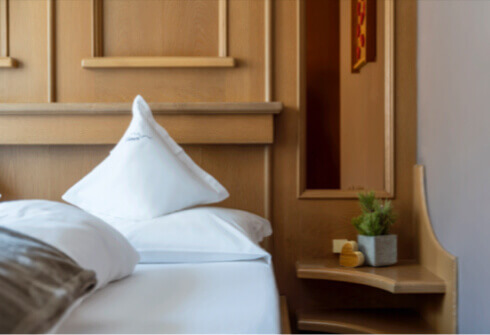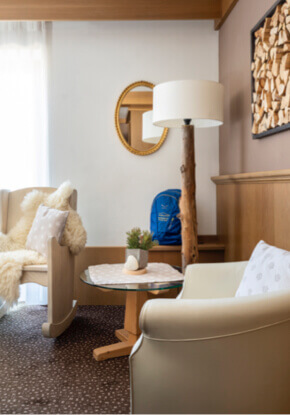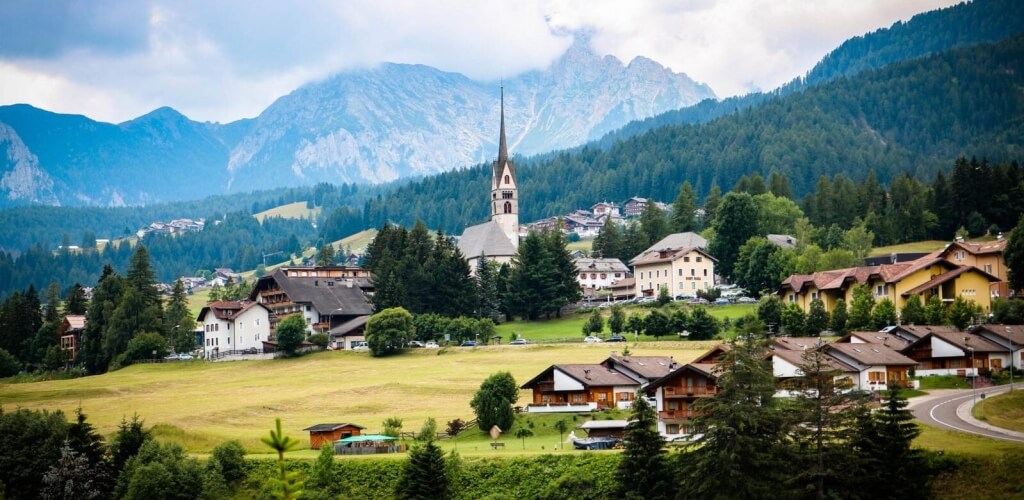Tel: +39 0462 764209
Email: info@hotelcatinaccio.com



Sèn Jan in Val di Fassa
Sèn Jan di Fassa is a splendid Dolomite tourist resort, which derives from the union of the villages of Vigo and Pozza.

It is located in Val di Fassa, an alpine valley famous for its great mountain vacation both for hiking and skiing. Located in the north-eastern end of the territory of the province of Trento, Sén Jan rises more or less in the middle of the long and enchanting Val di Fassa, squeezed between the base of the imposing Catinaccio massif and delimited to the east by the last offshoots of the Marmolada. As for the entire Val di Fassa, this town also receives a very large number of tourists every year, lovers of hiking and trekking at high altitudes, and in general, visitors who are passionate about winter sports. Here, the ski center of the Val di Fassa/Dolomiti Superski area is active, a very important ski facility in the region. Numerous excursions to the Catinaccio and Marmolada start from the bottom of the valley, characterized by different levels of difficulty. So, the area of Sén Jan is a perfect holiday destination for sportsmen, who will find many opportunities stay active, for families with children, who will be able to follow the simplest paths and enjoy the pristine meadows, but it’s quiet and Romantic landscapes are also ideal for young couples who are looking for a secluded and emotionally rich place.
The question of the denomination of Sén Jan di Fassa
With the Ladin name of Sén Jan, it indicates a new Italian municipality, which was officially established in January 2018 by the merger of two smaller municipalities: Pozza di Fassa and Vigo di Fassa. The fact that its name appears as a linguistic mix of Ladin and Italian has sparked controversy and caused the declaration by the Constitutional Court of the illegitimacy of the chosen name (December 7, 2018). In more Italian environments, the locality is called San Giovanni di Fassa. But the history of the union of the countries actually originates from much earlier through the progressive enlargement of the two respective municipalities up to the state of conjunction in which they find themselves today. This situation led to a referendum that took place on November 20, 2016, on the merger of the two municipalities of Vigo and Pozza and which was successful. The new municipality, given the Ladin majority present in the area, has opted to give itself a name that could mirror its identity. The towns of Pera, Costa, Larzonei, Monzon, Passo di Costalunga, Tamion, Val, and Vallonga are also part of the municipality of Sen Jan di Fassa.
How to get to Sén Jan di Fassa
Reaching Sén Jan di Fassa by car is not difficult: from the A22 Brenner motorway, you can exit at Egna-Ora (exit 75). From there, the Dolomites road, which passes through Fontanefredde and Nuova Redagno, leads to Val di Fiemme. Before entering Predazzo, follow the signs for Val di Fassa. Always by car, an alternative is to exit at Bolzano Nord (exit 77) and take the spectacular road that leads to Nova Levante and the Costalunga/Carezza pass (at an altitude of 1700 m!) And then descend to emerge directly at Vigo di Fassa. Even the bus, for those closest to you, can be a solution, through the SAD and Trentino Trasporti lines. You can also arrive by train from the Ora-Auer station in Val d’Adige, Bolzano, or Trento. For those who depart from much further afield, the closest airports to the Val di Fassa are Bolzano-Dolomiti, which is 40 km from Sén Jan, the Antonio Canova airport of Treviso at 160 km, or the Valerio airport Catullo of Verona at 180 km.
The story of Sén Jan di Fassa and its hamlets
The center of Vigo and Pozza date back to the Middle Ages, a bit like the other centers of the Val di Fassa, although the first findings can be traced back to the Paleolithic era. However, it was in the centuries after the year of 1000 that these small villages began to thrive with agriculture and livestock, until the end of the nineteenth century – the beginning of the twentieth century, when Sèn Jan and the neighboring countries gradually became tourist destinations very popular with enthusiasts of mountains, first mainly Austrians, then also Italians. It was in the first post-war period that the whole area of the valley passed from the territories of the Austro-Hungarian Empire to Italy and only after the Second World War did the country see its true rise in the tourism sector, particularly accelerated by the very first installations of modern ski lifts and the construction of major tourist accommodation facilities. So, today, Sén Jan di Fassa appears to have not one, but two historical centers: the hamlet of Vigo di Fassa (Vich in Ladin) and Pozza di Fassa (Poza). In particular, the center of Vigo is part of the list of the most beautiful villages in Italy and is located in a beautiful position, on the right side of the Avisio river, while Pozza is located a little further up, on the opposite side.
What to see in Sén Jan di Fassa
The historical part of Sén Jan di Fassa reserves many architectural beauties for its visitors: glimpses of picturesque alleys, historic buildings, and ancient houses. In particular, some of the most beautiful and ancient houses in the area are visible on the road that leads from Via Meida to the Alloch Alm. The barns throughout the area also deserve a careful look: the Fienile dei Cuori and the one located in front of the church of Pozza are structures of some value in the context of popular architecture. But what to see in particular in the area of Sén Jan di Fassa? Here are some examples of the major tourist attractions that blend art, culture, and tradition of the Fassa area.
The Church of San Giovanni
The ancient Church of San Giovanni, which dates back to the 15th century, is located in the small hamlet of Sén Spell Jan and is easily accessible from state road 48. This religious building, which is one of the oldest in the whole valley, houses inside some frescoes dating back to the 16th century. The structure is characterized by a Gothic style that can be easily identified even from afar with the high spire bell tower which houses six bells. Four of these date back to 1922, one to 1967, but the bell that has the greatest historical relevance is the largest. It was built in 1549, by master Ludovico Simonato who melted this bell for a weight of 2565 kg, still fully functional today after almost 500 years.
The hermitage of Santa Giuliana
On a small hill, in a more secluded place than the town, stands the hermitage of Santa Giuliana always in a strictly Gothic style. This site is considered the oldest religious center in the entire Val di Fassa, because, although the church that can be seen today dates back to the fifteenth century, in reality, since 1237, the existence of a previous church has been documented here, which was completely rebuilt two centuries later. Inside the Hermitage of Santa Giuliana (in Ladin language Sént Ujan), the main altar, built in 1517 by the artist Giorgio Artz of Bolzano, made of carefully carved wood, which has come down to us well preserved, deserves special attention. The frescoes that can be seen in the apse are of particular artistic importance, also from the second half of the fifteenth century. Outside the church, just next to it, there is a small chapel from the same period dedicated to San Maurizio. Of the four bells in the bell tower, the oldest is dated 1496 and is also the oldest in the entire Val di Fassa. These unique and precious instruments are played only on particular occasions.
The Austro-Hungarian cemetery
Just below the Church of Santa Giuliana, you can visit the Austro-Hungarian War Cemetery which houses the corpses of over 600 Austrian soldiers who died during the First World War on the mountains surrounding the Val di Fassa. The place is surrounded by fir and larch trees, inserted in a very peaceful dimension that recalls recollection. The names of the fallen are written on simple wooden crosses in memory of the atrocity of all conflicts. At the center of the cemetery, there is a small path from which you can reach a votive chapel located at an elevated point.
The Castle of San Nicolò
On a hill that rises at the mouth of the small Val San Nicolò, at the point where the Avisio river receives the waters of the Rio San Nicolò, stands the Mas, a sort of austere castle that survived the demolitions and reconstructions of the various buildings historians of the area. It is characterized by a tower that watches over the valley below and which was once in visual connection with the other ancient tower belonging to the Corte di Fassa, located in Vigo, which was the main seat of political and military power in the valley. During the Middle Ages, because of their elevated positions and favored by a wide view, the two castles could control the entire valley.
Ciampedie
In the center of the hamlet of Vigo there is the starting point of a modern cableway that connects the valley to the Ciampedie basin in a few minutes, located at an altitude of 2000 meters. Here tourists can enjoy a wonderful panoramic view of the entire Val di Fassa, the imposing Catinaccio, the pointed Vajolet towers and the pointed peaks of the Larsech. The area is served by refuges and huts and serves as a starting point for many routes leading to the Passo delle Cigolade or the Catinaccio. These are walks that can only be done in the summer, because during the winter the area is covered by snow and the whole Ciampedie area becomes the center of the Catinaccio ski area.
The Ladin identity in Val di Fassa and Sén Jan
The town of Sén Jan, in addition to being a renowned tourist resort for excursions and skiing, also has another peculiarity. This town, together with other municipalities in the area, is part of a minority linguistic enclave of Ladin language. According to a 2011 census, only 12.3% of the population residing in Sén Jan is native Italian, while 87.7% are Ladin-speaking and in particular, speak the Ladin variant called Brach. The Ladin geographical area occupies not only Val di Fassa but also three other famous Dolomite valleys, Val Badia, Val Gardena, and the area of the valley of Cortina d’Ampezzo, where Ladin has been spoken for centuries and the population recognizes it as cultural identity in its own right, rich in stories and traditions to be protected and handed down.
The Ladin Museum of Fassa
For those wishing to explore this cultural aspect, a visit to the Ladin Museum of Fassa managed by the Ladin Cultural Institute inaugurated in 2011, which is located in the hamlet of San Giovanni, may be particularly interesting. Inside the museum, you can observe objects and images that relate to Ladin traditions and culture, as well as tools and instruments related to agricultural and handicraft activities of the past, contextualized in excellent reconstructions of the environments. The exhibition traces the history of the valley from prehistory to the present. You can also visit other museum sites related to local crafts from the past, such as the mill and the malga in Pera di Fassa. The Mill represents one of the few still operating with water in the whole Trentino region and has three water wheels connected to two large blades which operate through the thrust given by the water, two machines for grinding cereals. Its origin is not exactly dated, but it is assumed that it can refer to the eighteenth century. The Malga is instead located at the Social Dairy of Val di Fassa, which since 2013 has reserved in its premises a special section dedicated to showing the secrets of traditional dairy art. Here, you can observe ancient tools and instruments that were used for the production of cheese and butter, an activity that has always had great importance in these valleys since ancient times.
So, the area of Sén Jan represents the ideal destination for a holiday able to blend nature and sport in the majesty of the mountains.
Sign up for our
newsletter!
